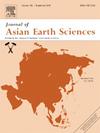Late Cretaceous and Cenozoic denudation of northern Central Vietnam examined through apatite fission track analysis
IF 2.7
3区 地球科学
Q2 GEOSCIENCES, MULTIDISCIPLINARY
引用次数: 0
Abstract
Tectonism is associated with uplift and exhumation but are commonly difficult to decipher due to large gaps in the stratigraphic record. Northern Central Vietnam has a highly dynamic exhumation and tectonic history affected by Middle Paleozoic and latest Permian to Triassic orogenies but also less known younger events. We explore this history through analysis of apatite fission tracks (AFT) together with stratigraphy and vitrinite reflectance, seismic data and new U/Pb zircon-ages. Late Cretaceous and Paleocene uplift and exhumation are here attributed to a poorly understood orogenic event. It was followed by mid- to Late Cenozoic doming and rift pulses and intervening periods of subsidence and basin development associated with regional SE Asian tectonism and establishment of South China Sea basins.
We document the evolution of NW-striking structural lineaments in northern Central Vietnam and their repeated reactivation. The complex Central Vietnamese fault block mosaic formed since the Paleozoic during different tectonic events associated with movements over these structural lineaments. Fault blocks were exhumed during Late Cretaceous and Cenozoic uplift phases, recorded by AFT in four discrete thermotectonic episodes around 82–70, 61–59, 43–42, and 19–15 Ma. The NW-striking crustal lineaments controlled deformation and uplift during Middle Paleozoic, latest Permian to Triassic and Late Cretaceous to Early Cenozoic orogenies. While the two former orogenies are well-known, the latter is poorly realized despite its super-regional nature across Indochina and SE China. It may relate to plate collision and the cessation of Paleo-Pacific subduction underneath SE Asia. Between the orogenic episodes, rifting reactivated the NW-striking crustal lineaments in the Carboniferous-Permian, Late Triassic and mid-Cenozoic causing basin development in Central Vietnam and neighboring areas. The mid-Cenozoic event led to the opening of the Hue Sub-basin at the Gulf of Tonkin margin. Uplift and one to one-and-a-half kilometer post-rift erosion sourced sediments to this sub-basin, including Upper Miocene petroleum reservoir sands.
求助全文
约1分钟内获得全文
求助全文
来源期刊

Journal of Asian Earth Sciences
地学-地球科学综合
CiteScore
5.90
自引率
10.00%
发文量
324
审稿时长
71 days
期刊介绍:
Journal of Asian Earth Sciences has an open access mirror journal Journal of Asian Earth Sciences: X, sharing the same aims and scope, editorial team, submission system and rigorous peer review.
The Journal of Asian Earth Sciences is an international interdisciplinary journal devoted to all aspects of research related to the solid Earth Sciences of Asia. The Journal publishes high quality, peer-reviewed scientific papers on the regional geology, tectonics, geochemistry and geophysics of Asia. It will be devoted primarily to research papers but short communications relating to new developments of broad interest, reviews and book reviews will also be included. Papers must have international appeal and should present work of more than local significance.
The scope includes deep processes of the Asian continent and its adjacent oceans; seismology and earthquakes; orogeny, magmatism, metamorphism and volcanism; growth, deformation and destruction of the Asian crust; crust-mantle interaction; evolution of life (early life, biostratigraphy, biogeography and mass-extinction); fluids, fluxes and reservoirs of mineral and energy resources; surface processes (weathering, erosion, transport and deposition of sediments) and resulting geomorphology; and the response of the Earth to global climate change as viewed within the Asian continent and surrounding oceans.
 求助内容:
求助内容: 应助结果提醒方式:
应助结果提醒方式:


